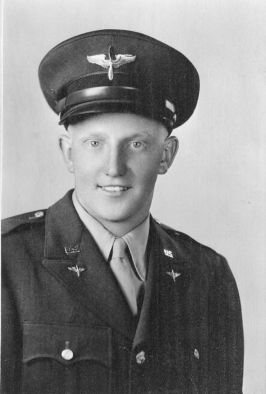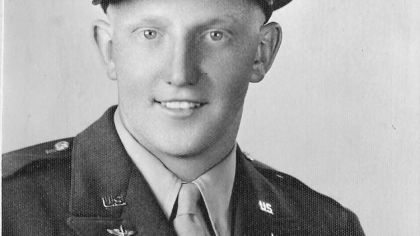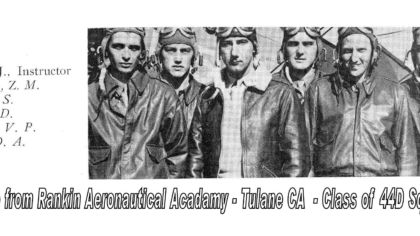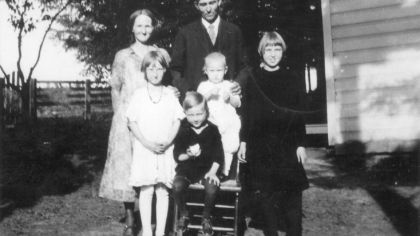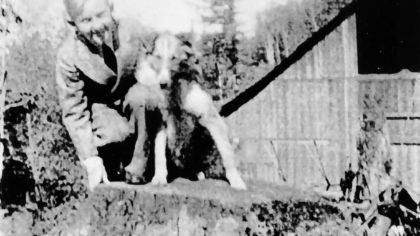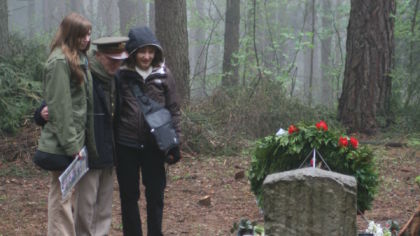Marion Kirkham
Brothers in Arms
Virgil Paul Kirkham and Marion Kirkham
In the shadow of Draženovský Hill, a relatively small hill sloping up from Trhanov (near Domažlice), a small stone memorial lies, with an inscription in Czech, stating that this was the site where 1st Lieutenant Virgil Paul Kirkham (born November 27, 1924), lost his life on April 30, 1945. A slight man, wearing a U.S. Air Force uniform, has appeared at the site several times since 1990, to pay homage to the young Allied pilot who was killed there while fighting the Nazis at the end of World War II. He is none other than Virgil’s brother, Marion Kirkham.
The U.S. Air Force, especially the Ninth Air Force, had ruled the skies over the southwestern corner of the Protectorate of Bohemia and Moravia since March 1945 – P-51 Mustangs and P-47 Thunderbolts literally paralyzing all road and rail transportation. With the end of the war drawing near, large columns of withdrawing enemy troops came into the pilots’ sights with increasing frequency. On April 30, 1945, Virgil Paul Kirkham, a member of the famous 362nd Fighter Group, got ready to go on his 85th combat mission. It was supposed to be his last mission before going on furlough – but it ended up being the last day of his life.
Virgil Kirkham, the formation leader, took off from a base near Frankfurt. After flying for a bit, the pilot in the formation’s second position returned to the airport, due to propeller problems. Lieutenant Kirkham called ground control and immediately received coordinates for the target that was to be bombed. The fighters supported each other as they approached the target and attacked armored cars and enemy tanks.
Approximately 12:45 p.m., the three American pilots, led by Lieutenant Kirkham, spotted a German truck convoy on the road between Trhanov and Klenčí pod Čerchovem. They opened fire, but during the low approach, Kirkham’s left wing caught on a treetop. It was 12:50 p.m. when his American P-47 Thunderbolt fighter plane (serial number 44-89700), crashed at full speed into the wooded slope of Draženovský Hill, north of Trhanov. According to the Missing Air Crew Report, “1st Lieutenant Kirkham was hit by fire from land targets.” An armored plate, designed to protect the pilot’s seat against fire from the rear – preserved to this day – supports the report. The headrest had been shot through by a projectile that might have been fired from somewhere near the train station, during the enemy’s return fire. Virgil Kirkham was the last U.S. fighter pilot to be killed in the Protectorate of Bohemia and Moravia during the fight against Nazism.
The wooden cross that commemorated the site of this young pilot’s tragic death was later replaced with an engraved stone plaque. It is here – to this place where Virgil lost his life – that Virgil’s older brother, Marion Kirkham, repeatedly returns. He’s a cheerful man – overflowing with energy and gratitude – one can’t help but wonder where he gets so much optimism, in spite of the wrongs he has encountered in his life. But Marion just continues to smile, as if he were trying to pass on his good mood to everyone around him and offer them his life experiences.
Marion’s life was also affected by the war. After graduating from Corbett High School and spending a short time in Alaska, Marion waited to be drafted at any time. By then, the war was raging and he assumed, as did a number of other young men, that he would also be sent to the front. Around that same time, he learned about a program whose goal was to train a sufficient number of flight instructors to help drill new Army pilots. Because he was attracted to flying, he decided to register at the Lewiston State Normal School (now Lewis-Clark State College), in Idaho. After completing basic and advanced training, he finished the program, returned home, and waited for the draft.
Marion joined the Army in August 1943, going through basic training in Kerns, Utah. As with every beginning, it was difficult. He underwent rigorous training and preparation for harsh conditions in the field, including living in tents heated with coal-burning stoves. Thanks to his prior training, the Air Force accepted Marion into their Air Cadet program – which was designed to recruit as many future pilots as possible. Following further studies, Marion earned his pilot wings at Luke Field, near Phoenix, Arizona, in August 1945.
At the beginning of that month, Marion and Virgil’s mother, Mary, had passed away and Marion got leave to attend the funeral. By the time he returned to Luke Field, the war was over. He was discharged in October of 1945, returning to civilian life with praise from his commanders, who valued his service and his interest in flying. Marion and Virgil weren’t the only ones in their family who served in the army. Their sister, Dorothy, also lent a hand to the cause when she became a member of the Women’s Army Corps (WAC), serving in the rank of sergeant in New Guinea.
After returning home, Marion started farming in 1946. Later, he grew certified seed potatoes, strawberries, and daffodils. He returned to the life to which he was accustomed during his childhood, and which he fondly describes here: “We lived in the country. Dad was a farmer and we raised animals, so we had lots of chores to do. The girls were older and did a lot; but as we grew, the girls moved away and Virgil and I worked the farm together with our folks. Virgil and I were good friends and, like all farm kids, we made our own fun. A squash could, and often did, become a football for throwing back and forth. We were isolated in the country and also in the midst of the depression, so we were lucky to have the squash to throw – and the few we busted weren’t missed. We had, of course, no electricity, so, no radio and no running water. There was plenty to keep two boys out of too much trouble. In the evenings we would play chess and card games and really had a good life. We really appreciated all we had.”
It was after the fall of communism, in 1989, that Marion first located the site where his brother had died – Virgil Paul Kirkham, a member of the famous 362nd Fighter Group, a unit that did its part to help achieve the final victory over Hitler’s Germany. Marion has returned to Trhanov several times since then, and he never fails to visit that small memorial stone concealed in the dense forest during his trips to the Czech Republic. He is happy to see that there are still people who pay their respects by laying flowers at the memorial. For Marion, it’s proof that his brother didn’t die in vain, but, in fact, he contributed to restoring freedom to future generations.
From book 500 hours to victory
